MARK BANDO'S WEBSITE
Equipment 4
I.D. Bracelets
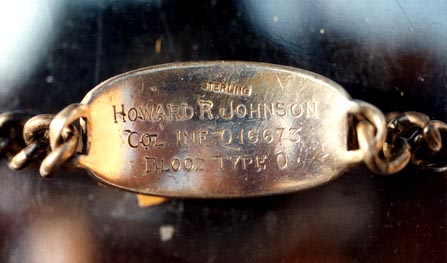 Jumpy's I.D.Bracelet
Paratroop officers were fond of wearing sterling silver Identification bracelets at the wrist, usually bearing rank, name and serial number. The example shown above belonged to Colonel Howard R. Johnson, C.O. of the 501 PIR. Below the Sterling mark, it bears the inscription:
Jumpy's I.D.Bracelet
Paratroop officers were fond of wearing sterling silver Identification bracelets at the wrist, usually bearing rank, name and serial number. The example shown above belonged to Colonel Howard R. Johnson, C.O. of the 501 PIR. Below the Sterling mark, it bears the inscription:
"Howard R. Johnson
Col. Inf. 0-16673
Blood Type O"
On the top (reverse) side is a full-sized set of parachute wings. Colonel Johnson probably wore this bracelet when making over 100 parachute jumps in the states, before sailing to England. He left the bracelet with his wife, Mary who resided at Pinehurst, N.C. while he was overseas. Many of his personal possessions disappeared in Holland following Colonel Johnson's death in October, 1944. This bracelet appears courtesy of his son, Joe Johnson, who served in UNPIK and Special Forces in the 1950's and 60's and who retired as a Major.
ID Bracelet of Lt.Edmund Wierzbowski
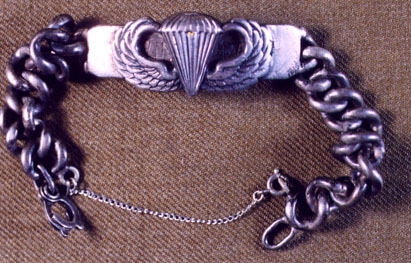 Above:the obverse of Lt. Edmund Wierzbowski's ID bracelet. You'll note this started simply as a name/serial number bracelet, then the jump wings were mounted (superimposed) over Ed's last name.
Above:the obverse of Lt. Edmund Wierzbowski's ID bracelet. You'll note this started simply as a name/serial number bracelet, then the jump wings were mounted (superimposed) over Ed's last name.
Ed was Joe Mann's platoon leader in H/502, and was with him when he won the Congressional Medal of Honor near Best, Holland.
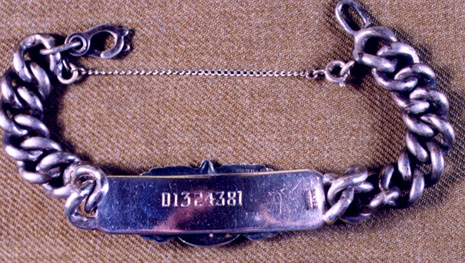 Here's the reverse of Ed's bracelet-this bears his serial number (I checked it against wartime rosters and it matches), also the words "Sterling Mexico". I just acquired this item from Ed's son, Jason (Nadine's brother) in April, 2004.
Here's the reverse of Ed's bracelet-this bears his serial number (I checked it against wartime rosters and it matches), also the words "Sterling Mexico". I just acquired this item from Ed's son, Jason (Nadine's brother) in April, 2004.
 This one belonged to William E. Parks of E/502, courtesy Emmanuel Allain collection, SME, France.
This one belonged to William E. Parks of E/502, courtesy Emmanuel Allain collection, SME, France.
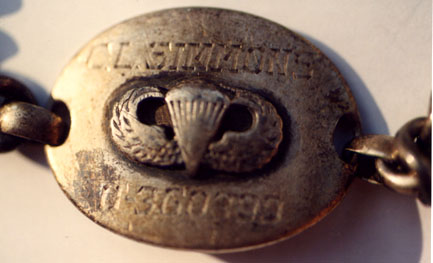 This is a detail of the bracelet worn by Captain, Major and LTC Cecil L. Simmons, of H, RHQ, and 3rd Bn HQ, 502 PIR, in WW2. It is in the webmasters collection along with Cec's painted helmet, Normandy Jumpsuit, M-3 blade dated Case trench knife, musette bag, and other items.
This is a detail of the bracelet worn by Captain, Major and LTC Cecil L. Simmons, of H, RHQ, and 3rd Bn HQ, 502 PIR, in WW2. It is in the webmasters collection along with Cec's painted helmet, Normandy Jumpsuit, M-3 blade dated Case trench knife, musette bag, and other items.
Vet-Acquired Dogtags
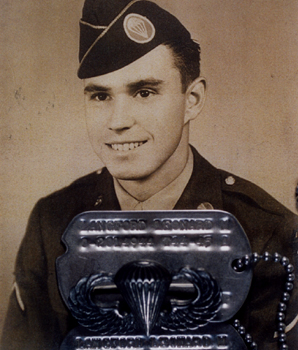
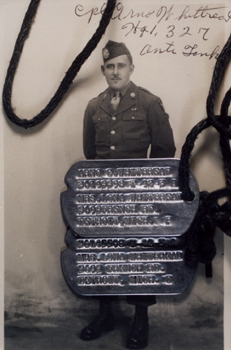 Corporal Leonard Langford was a paratrooper in the LMG platoon of HQ Co. 2/502 PIR. Shown here are Len's dogtags, a duplicate set of jump wings and a portrait of him made in 1943. He survived all the missions of the 502 and lived in Florida with his wife Laverne after the war.
Corporal Leonard Langford was a paratrooper in the LMG platoon of HQ Co. 2/502 PIR. Shown here are Len's dogtags, a duplicate set of jump wings and a portrait of him made in 1943. He survived all the missions of the 502 and lived in Florida with his wife Laverne after the war.
Arno Whitbread was a glider infantryman who was in the regimental anti tank platoon of HQ/327th GIR. This platoon was the only part of the 327th to land in Normandy by glider on the evening of 7 June, 1944. They brought-in 37mm anti tank guns while the rest of their regiment arrived the next day-by SEA. Arno wore his dogtags strung on a piece of shoelace, as shown.
Arno belonged to the original Detroit 'Nuts Club' Chapter of the 101st ABD Assn. He is still a regular at the SE Michigan 'Lunch Bunch' as of 2007.
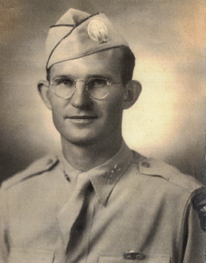
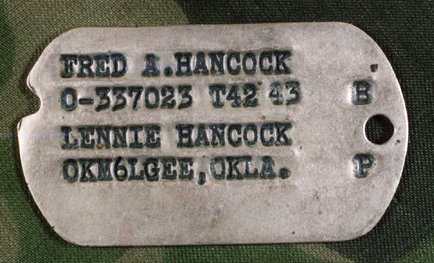 Fred Hancock was commissined as a 2nd Lt in 1935, with the Oklahoma National Guard (45th ID)-He commanded Charlie Co. of the 502 PIR in Normandy and Holland. Note the typo error on his dogtag, for Okmulgee, Oklahoma.
Fred Hancock was commissined as a 2nd Lt in 1935, with the Oklahoma National Guard (45th ID)-He commanded Charlie Co. of the 502 PIR in Normandy and Holland. Note the typo error on his dogtag, for Okmulgee, Oklahoma.
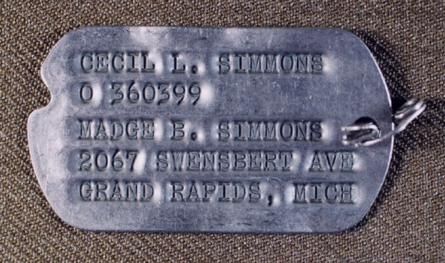
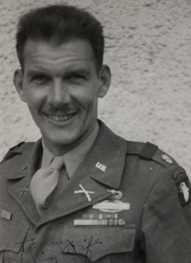 Cecil L. Simmons was in the Michigan National Guard, 31st Inf Div before WW2. He commanded H/502 in Normandy, RHQ Co. 502 in Holland, was XO of 3rd battalion at Bastogne and became 3/502 commander after Major Stopka was KIA on 14 January, 1945. He was the last battalion commander of 3/502 in WW2 and the only one of three commanders who survived the war.
After WW2 he became a two star general and commander of the entire Michigan National Guard.
Cecil L. Simmons was in the Michigan National Guard, 31st Inf Div before WW2. He commanded H/502 in Normandy, RHQ Co. 502 in Holland, was XO of 3rd battalion at Bastogne and became 3/502 commander after Major Stopka was KIA on 14 January, 1945. He was the last battalion commander of 3/502 in WW2 and the only one of three commanders who survived the war.
After WW2 he became a two star general and commander of the entire Michigan National Guard.
Big Cec was also a policeman in Grand Rapids, MI before WW2 and a Traffic Engineer for that city after WW2.
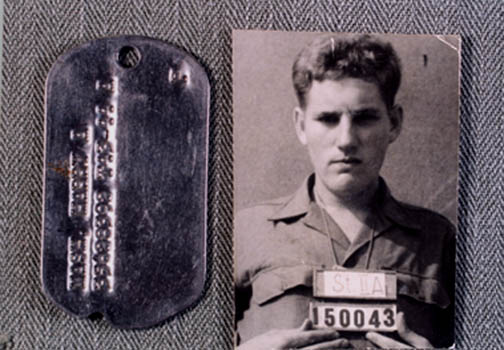 Harry Mash of the 326th Airborne Medical Company (AMC) was among the 1/3 of his company who parachuted into France on D-day. Unfortunately, the Air Corps dropped Harry up near Montebourg, where he was taken prisoner while walking along the Carentan-Cherbourg railroad line. He spent the duration as a POW. The mugshot which accompanies his dogtag was made at a Stalag by German military personnel.
Harry Mash of the 326th Airborne Medical Company (AMC) was among the 1/3 of his company who parachuted into France on D-day. Unfortunately, the Air Corps dropped Harry up near Montebourg, where he was taken prisoner while walking along the Carentan-Cherbourg railroad line. He spent the duration as a POW. The mugshot which accompanies his dogtag was made at a Stalag by German military personnel.
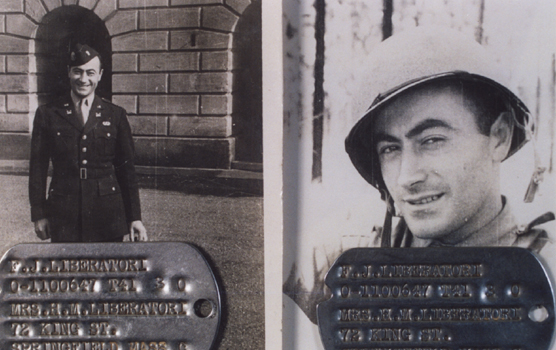 Captain Francis 'Libby' Liberatori was an architecht from Springfield, MA. He commanded Company 'C' of the 326th Airborne Engineer Bn, until he was seriously wounded in the spine, in Normandy. This rendered him a paraplegic for the rest of his life. Libby got a gangplank promotion to Major and continued his career as architect until his death in the early 1970s. He was active in MA veterans' affairs after WWII.
Captain Francis 'Libby' Liberatori was an architecht from Springfield, MA. He commanded Company 'C' of the 326th Airborne Engineer Bn, until he was seriously wounded in the spine, in Normandy. This rendered him a paraplegic for the rest of his life. Libby got a gangplank promotion to Major and continued his career as architect until his death in the early 1970s. He was active in MA veterans' affairs after WWII.
Officer ID Cards
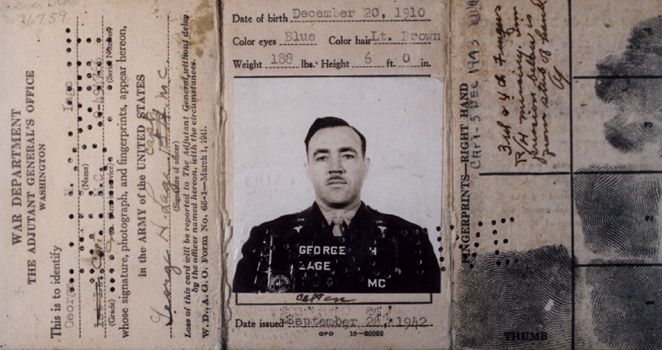 U.S. Army Officers' tri-fold I.D. card, inside shown above for Captain George Lage HQ/2 502 PIR. Doc Lage ran the famous First Aid Station at Holdy, France on D-day and was awarded the Silver Star Medal for his oustanding performance as 2nd Bn surgeon for the Deuce. In civilian life, Lage was a gynecologist.
U.S. Army Officers' tri-fold I.D. card, inside shown above for Captain George Lage HQ/2 502 PIR. Doc Lage ran the famous First Aid Station at Holdy, France on D-day and was awarded the Silver Star Medal for his oustanding performance as 2nd Bn surgeon for the Deuce. In civilian life, Lage was a gynecologist.
When he was discharged for medical reasons, after being shot through the chest on 18 September, 1944, the word "INACTIVE" was punched through the I.D. using multiple holes to spell the word.
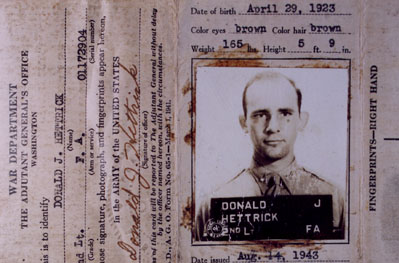 Here's another example of ID, this one from an artillery officer, Lt. Donald J. Hettrick, D/377th PFAB. Lt. Hettrick's exploits as a artillery forward observer attached to the 502 PIR appear in the webmaster's 7th book-'101st Airborne The Screaming Eagles in WW2', released in September, 2007.
Here's another example of ID, this one from an artillery officer, Lt. Donald J. Hettrick, D/377th PFAB. Lt. Hettrick's exploits as a artillery forward observer attached to the 502 PIR appear in the webmaster's 7th book-'101st Airborne The Screaming Eagles in WW2', released in September, 2007.
WIA
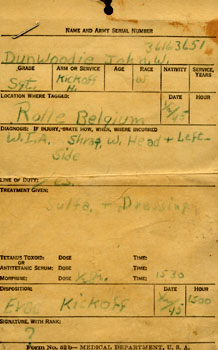 The tag nobody wanted to get. This certified eligibility for a Purple Heart Medal, when the recipient was wounded in action. This specimen dates to the Bastogne period and indicates that Sgt John Dunwoodie 36163651 received shrapnel to the head and left side. He initially received sulfa and dressings. John was a member of H/502, and was evacuated from the Kickoff aid station at Rolle, Belgium January 2, 1945. webmaster's collection c/o the late Jack Dunwoodie
The tag nobody wanted to get. This certified eligibility for a Purple Heart Medal, when the recipient was wounded in action. This specimen dates to the Bastogne period and indicates that Sgt John Dunwoodie 36163651 received shrapnel to the head and left side. He initially received sulfa and dressings. John was a member of H/502, and was evacuated from the Kickoff aid station at Rolle, Belgium January 2, 1945. webmaster's collection c/o the late Jack Dunwoodie
P.O.W. Dogtag
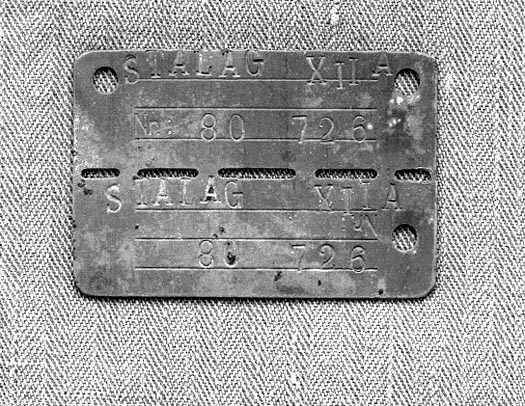 Another item of equipment nobody wanted was this German-issued
Prisoner of War dogtag, given to those unfortunate enough to be long-term guests of the German government. This one was issued to George King of H/501, who was captured on D-day near Baupte, France (misdropped). After a stay at Hungry Hill (Tessy sur Vire, near St Lo), then marching through Paris, George went to Stalag XII-A at Limburg, Germany, where this I.D. tag was issued. It is made of zinc or some other pot metal and perforated in the center like German military dogtags, to be seperated if the wearer was killed or died. Limburg was the main processing center for American enlisted prisoners taken in NW Europe after D-Day. After a mugshot was taken and dogtag issued, the prisoner was usually sent to another Stalag, deeper in Germany. Officers were segregated and sent to Oflags. When a flood of American PWs started coming in from the Huertgen and the Bulge in late 1944, Limburg was supplemented by Gerolstein and the niceties of mugshots and I.D. tags were discontinued for
the duration of WW2.
Another item of equipment nobody wanted was this German-issued
Prisoner of War dogtag, given to those unfortunate enough to be long-term guests of the German government. This one was issued to George King of H/501, who was captured on D-day near Baupte, France (misdropped). After a stay at Hungry Hill (Tessy sur Vire, near St Lo), then marching through Paris, George went to Stalag XII-A at Limburg, Germany, where this I.D. tag was issued. It is made of zinc or some other pot metal and perforated in the center like German military dogtags, to be seperated if the wearer was killed or died. Limburg was the main processing center for American enlisted prisoners taken in NW Europe after D-Day. After a mugshot was taken and dogtag issued, the prisoner was usually sent to another Stalag, deeper in Germany. Officers were segregated and sent to Oflags. When a flood of American PWs started coming in from the Huertgen and the Bulge in late 1944, Limburg was supplemented by Gerolstein and the niceties of mugshots and I.D. tags were discontinued for
the duration of WW2.
The Famous Zippo Lighter
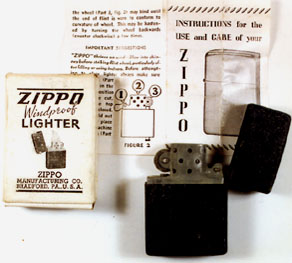 The combat versions of the Zippo cigarette lighter existed in a rough black and olive green paint scheme. This specimen is unused, still in the box, with instructions and comes from the effects of Captain Bob Speer, HQ/2 502 PIR.
The combat versions of the Zippo cigarette lighter existed in a rough black and olive green paint scheme. This specimen is unused, still in the box, with instructions and comes from the effects of Captain Bob Speer, HQ/2 502 PIR.
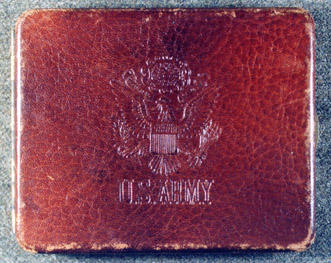 Above is a leather-covered, embossed cigarette case, for a U.S. army officer. Of course it is sized for the short, wartime cigarettes, which had no filters. This specimen was carried by LTC Cecil L. Simmons of 3/502.
Above is a leather-covered, embossed cigarette case, for a U.S. army officer. Of course it is sized for the short, wartime cigarettes, which had no filters. This specimen was carried by LTC Cecil L. Simmons of 3/502.
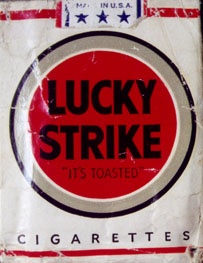 Pre WW2 Lucky Strike cigarettes came in a green package. Later, when green dye was needed for military purposes, the slogan was born:"Lucky Strike Green Has Gone To War". Thereafter, Luckies came in a white pack as above, a form of packaging which remains basically unchanged to this day. For some unknown reason, a soldier in the 1st Special Service Force mailed this empty Lucky pack home to his parents, in a letter from Italy.
Pre WW2 Lucky Strike cigarettes came in a green package. Later, when green dye was needed for military purposes, the slogan was born:"Lucky Strike Green Has Gone To War". Thereafter, Luckies came in a white pack as above, a form of packaging which remains basically unchanged to this day. For some unknown reason, a soldier in the 1st Special Service Force mailed this empty Lucky pack home to his parents, in a letter from Italy.
V42 Fighting Knife
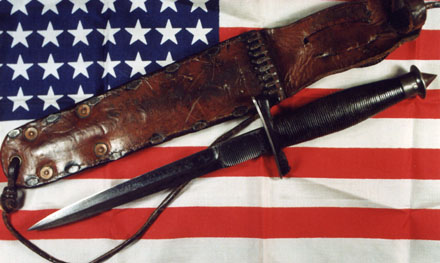 The Case knife company made about 4,000 of these fighting knives in WW2. They were issued only to the North Americans of the 1st SSF. The narrow blued steel blade tapers to a sharp point, with a double edged blade and a"thumbprint ricasso", which indicated where the user should place his thumb. This example has a shortened leather scabbard, probably for wear on the ankle. This particular example was brought to the 501 PIR by a Force replacement in January, 1945. A 1/501 medic later evacuated that Force vet with wounds from Alsace in February, 1945. The medic acquired the V42 knife at that time, but unfortunately failed to record the name of the casualty. The knife probably saw use at Anzio and in Southern France with its original owner.
The Case knife company made about 4,000 of these fighting knives in WW2. They were issued only to the North Americans of the 1st SSF. The narrow blued steel blade tapers to a sharp point, with a double edged blade and a"thumbprint ricasso", which indicated where the user should place his thumb. This example has a shortened leather scabbard, probably for wear on the ankle. This particular example was brought to the 501 PIR by a Force replacement in January, 1945. A 1/501 medic later evacuated that Force vet with wounds from Alsace in February, 1945. The medic acquired the V42 knife at that time, but unfortunately failed to record the name of the casualty. The knife probably saw use at Anzio and in Southern France with its original owner.
RUPERT PARA DUMMIES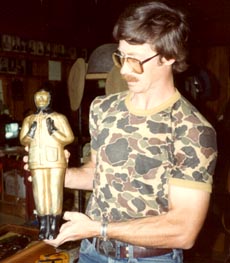
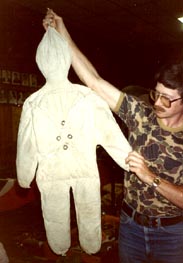 Miniature paratrooper figures were dropped before the Airborne landings on D-Day, as a diversion, to confuse the German defenders in Normandy. I don't know how many different types of these Ruperts were used. Nor do I know precisely where they were dropped, in what quantities, and to what effect. The two examples shown above are in the collection of Michigan Airborne collector Cary Comstock.
Miniature paratrooper figures were dropped before the Airborne landings on D-Day, as a diversion, to confuse the German defenders in Normandy. I don't know how many different types of these Ruperts were used. Nor do I know precisely where they were dropped, in what quantities, and to what effect. The two examples shown above are in the collection of Michigan Airborne collector Cary Comstock.
Update, March, 2014-Here's some accurate detail about the 2 para dummies shown here, from historian Jon Gawne, who has written an
entire book on D-day deceptions:
"The metal one is a US made Oscar(as he resembles the film statue). They did not have any pyrotechnics, and were never really used except here in the states. There are a few around, but the chutes are really (really) rare (and I have one!) The burlap ones are not OSS, but the British Rupert-of which there were a number of different models with differing pyrotechnics in them. They were used as part of 'Operation Titanic', in Normandy, which initially was to be 4 dummy drop zones (not scattered all over the place as some people claim), but for various reasons, only two of the DZ were used. Along with them, an SAS team was dropped to play audio recordings on a record player of all things!
They were later claimed effective, as they did draw in some German troops, and then doubly effective, as the germans found the dummies and it added to the idea that Normandy was just a feint".
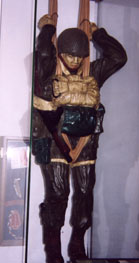
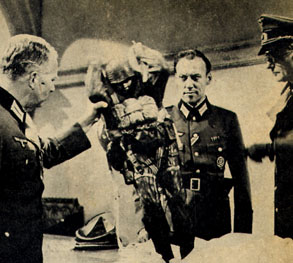 This is one of the much more detailed Hollywood Ruperts, used in the film 'The Longest Day'. It is in the collection of Michel Detrez, the consumate US Airborne collector in Wezembeek-Oppem, Belgium. Also, a still from the classic movie shows German officers examining a Rupert recovered from the Allied drop.
This is one of the much more detailed Hollywood Ruperts, used in the film 'The Longest Day'. It is in the collection of Michel Detrez, the consumate US Airborne collector in Wezembeek-Oppem, Belgium. Also, a still from the classic movie shows German officers examining a Rupert recovered from the Allied drop.
Prototype Parachute
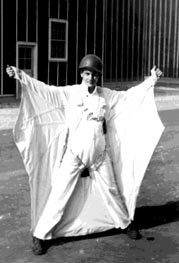 Before you laugh, bear in mind that military parachuting was still in the experimental stages during WW2. This Bat design was actually tested in late 1942, at Ft Benning, resulting in the deaths of two Riggers. Chalk those deaths up to extreme devotion to duty, as it was all a part of the war effort. Yet
another example of the Greatest Generation. Who could defeat an army containing men like those? This defines the slogan "Airborne-All the Way!" The 82nd Airborne man who took this photo wrote on the reverse "I'd like to test this design myself from 6,000 feet, if I could make some modifications." He
didn't specify what those modifications would be.
Before you laugh, bear in mind that military parachuting was still in the experimental stages during WW2. This Bat design was actually tested in late 1942, at Ft Benning, resulting in the deaths of two Riggers. Chalk those deaths up to extreme devotion to duty, as it was all a part of the war effort. Yet
another example of the Greatest Generation. Who could defeat an army containing men like those? This defines the slogan "Airborne-All the Way!" The 82nd Airborne man who took this photo wrote on the reverse "I'd like to test this design myself from 6,000 feet, if I could make some modifications." He
didn't specify what those modifications would be.
A 506th vet told me recently that in late 1942, there was a debate at TPS, regarding how many feet of altitude were required for a reserve parachute to deploy successfully. A small red headed Sgt who was an instructor at TPS said he would prove it could be done from 250 feet, by jumping from the top of one of the free towers and yanking the ripcord handle. He actually performed this stunt, proved his theory, and lived to tell about it. This was a terrific feat of raw courage.
Under Construction





























